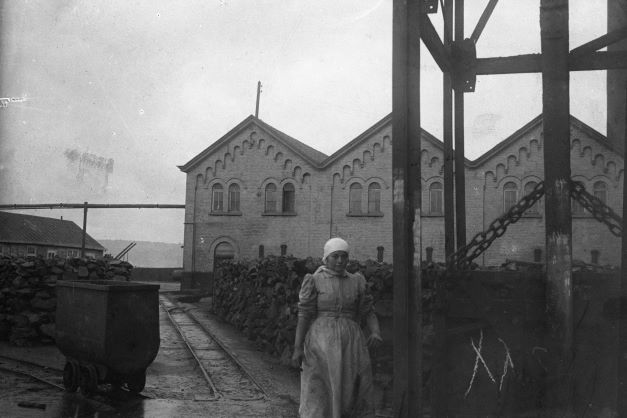The ghostly figures, in our first photograph in this blog, shed some light on a now forgotten aspect of coal mining – women’s work on the pit top.

At first we thought that these rare photographs (published here for the first time) might have been taken in the north eastern part of Derbyshire, possibly at a colliery of the Staveley Coal and Iron Company. We also thought that they were of the First World War period or later. The short series of plate glass negatives (of which we reproduce three), shows women engaged in pit-top work, sorting and stacking coal.
Though women were banned from working underground in the Mines and Collieries Act of 1842, following the Children’s Employment Commission report of the same year, this didn’t stop pit-top work. Nationally this was fairly common – even by 1900 4,808 females were employed against 155,829 males working at coal, iron, shale and clay mines. But it’s thought that no women were employed in the Derbyshire coalfield during the nineteenth century. This resulted in most women staying at home.
The Derbyshire Miners’ Association wanted to see ‘a total prohibition of female labour about our mines’ in response to a proposed Coal Mines bill of 1911. But this amendment to the bill was defeated, with the aid of women suffragists. This caused some consternation with one MP saying that the ’university women’ responsible for the amendment’s defeat did not understand the hard nature of the work involved.

In 1915, following the onset of the First World War, nationally it was thought that employers and workers would be best placed to look, jointly, at employing more women on the surface (along with other measures to increase productivity).
Though reports of actual employment in Derbyshire are scant some have surfaced. For example in March 1916 the Derbyshire Miners’ Association was protesting after it was reported that ‘women workers had been introduced to certain pits in the county.’ This appears to have centred on a dispute at Waleswood Colliery. The need to replace men at work had presumably started this move. In 1916 some 12,000 men had left the pits in Derbyshire to join the army.
In some areas of the country the employment of women is fairly well documented, but in Derbyshire, with its early absence of women, it is possibly less so. Later, as coal owners were forced to consider welfare provision at the pit top, women played their role in what might be termed traditional work – occupational nursing and canteen work are just two.
Although our ‘ghostly figures’ were first thought to be possibly of Derbyshire origin, but are probably not, they do throw some light on a sometimes-forgotten part that women played in the coal industry of past years.

Sources used in this blog:
Angela V John, By the seat of their brow. Women workers at Victorian coal mines, London: Routledge & Kegan Paul (1984).
JE Williams, The Derbyshire miners. A study in industrial and social history, London: George Allen & Unwin (1962).
Derbyshire Courier 11 March 1916, 22 April 1916 and 5 September 1916.
Our thanks to one of our VCH research group members for allowing us to share these photographs. We would be interested to hear views on where these photographs might be.

Not sure that the lack of women working in the coal industry can justify the assumption that the majority of women stayed at home. Do you mean married women? It would be interesting to analyse the census returns and compare women’s occupations in Derbyshire with areas of the country where women are known to have worked in collieries. Could it be that women in Derbyshire didn’t work in the collieries because there was a sufficient number of jobs available to them in other industries and occupations such as domestic service?
An interesting point about women staying at home. We don’t think that much work has actually been undertaken about women working in collieries in Derbyshire as they generally didn’t work there, thanks to the activities of the trades union movement. Maybe at some stage someone will take this up and look in some greater detail at occupations of women in the coalfield areas (unless you can shed any light on whether there have been any studies of the nature already). Thanks for your comments.
I read quite a lot about women employed in coal mining, in a book with many illustrations, but unfortunately I cannot now recall either the book’s title or author. I think the book had a North East bias, in the collieries of Northumberland and Durham, but my memories of exact places are now hazy. The book placed much emphasis on the gruelling underground work done by women and children, when women could spend over half the day underground, bent double, hauling laden sleds by means of chains attached to a large body belt. The photos you have shown don’t jog any memory cells I’m afraid. It is strange attire, not like the sacking which appeared in the photos in the book I mentioned. Is it possibly from a colliery owned by a very wealthy person, where better conditions prevailed ? Or even Scottish ?
Thanks for your comments. Unfortunately we can’t directly identify the book you mention.